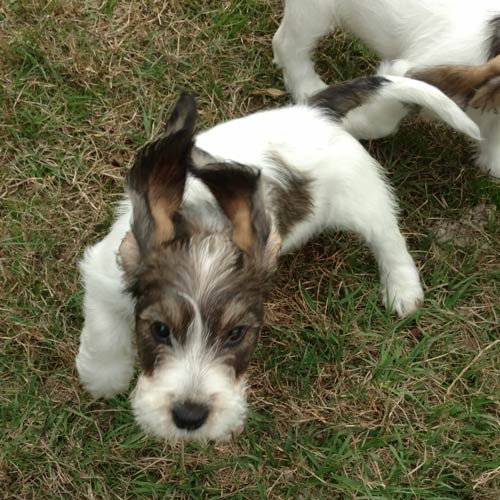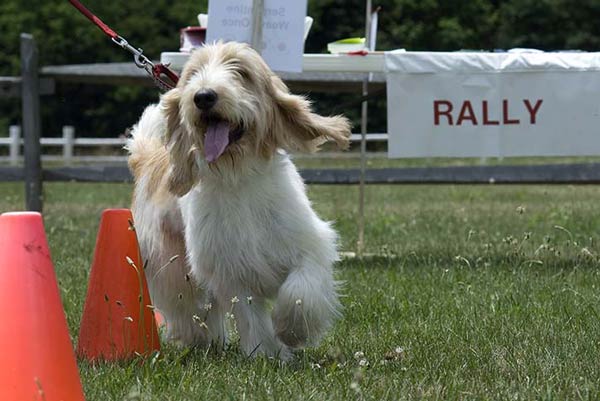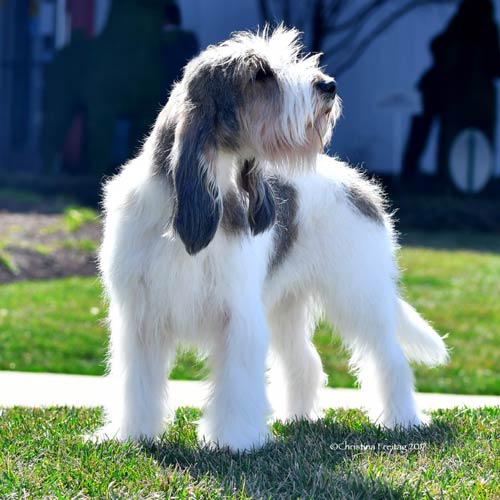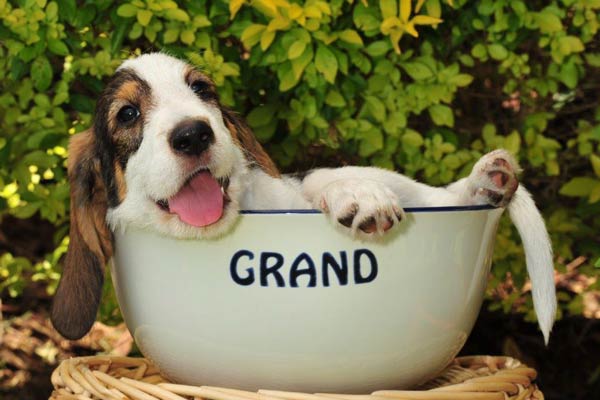
How do you feel about a grand adventure, with a bit of challenge and surprise tossed in?
If this appeals to you, the Grand Basset Griffon Vendéen may satisfy that urge.
With fewer than 400 in the United States, the rough-coated scenthound, a native of France, is one of two new breeds the American Kennel Club (AKC) is introducing into companion events competition this month, including into the Hound Group for conformation.
Grands weigh between 40-45 pounds and have a life expectancy of 13-15 years.
Don’t think for a minute, however, that there will be an explosion of GBGVs nationwide any time soon. “The GBGV is not easy to breed,” emphasizes Corey Benedict, of Howey-in-the Hills, Fla., president of the Grand Basset Griffon Vendeen Club of America, who along with his partner, Brent Humphrey, has been breeding and showing GBGVs since 2004.
“They are not cookie-cutters, as breeders often say, and consistency is difficult to achieve. We encourage the breeding of out-crosses (dogs not related), which means we do no line breeding, This breed has a very small gene pool, and getting new pedigrees that will pass health clearances is not easy.”
Most European breeders, adds Benedict, “do not prioritize health testing comparable to that performed in the U.S.” Since all of the GBGVs imported to the U.S. have originated in Europe, it was crucial, he continues, “to begin breeding programs with dogs that have passed health tests in order to establish a base line for future generations and insure the preservation of the quality of the breed.”

Oh, my, it’s been a tiring day,” says Stella, a young Grand Basset Griffon Vendéen, bred by Cindy and Phil Wilt of Mobile County, Alabama. The pet pup is the best friend of a 3-year-old boy in a military family stationed in Florida. The breed is eligible to compete in all American Kennel Club companion events beginning this month, including the Hound Group in conformation.
“We only breed – and own – dogs that have Orthopedic Foundation for Animals (OFA) hip final clearance and current Canine Eye Registration Foundation (CERF) registration of the eyes as clear or the equivalent of Federation Cynologique Internationale (FCI) clearances. There have been cases of epilepsy and lion’s jaw disorder (excessive abnormal growth on the skull and lower jaw usually seen in dogs 3-8-months old) in the breed. Thankfully, we have not produced either.”
Cindy Wilt, a member of the Grand Basset Griffon Vendeen Club of America board of directors, along with her husband, Phil, of Mobile, Ala., started with Petit Basset Griffon Venden (PBGV) in 2007 and became interested in Grands after seeing one at a dog show in Atlanta. “The similarity to Petits was the obvious attraction, and the larger size without being overly large, was something that we had been wanting to add to our family for some time,” she says. They imported their first Grand, Sophie, from the Netherlands in 2012.
Benedict and Wilt praise the breed’s suitability as a family companion, but they also point out its challenges.
Benedict says, “They are bred to hunt in packs in France, so they should get along with other pets. They love kids, but being a hound means they have to be kept in a fenced-in area or on a lead. Their temperaments are more laid-back than those of their cousins, the PBGV.

Chuey, a Grand Basset Griffon Vendéen, competes in agility at the 2007 American Kennel Club Foundation Stock Service Expo. Chuey was the first GBGV to be awarded an AKC companion event title.
“While they love their families, like many breeds they need to learn their place in the pack at an early age. If you are not a leader, they will become the leader. We do not encourage owners to let them get on the furniture and strongly suggest crate training them as a puppy.”
Benedict cautions, “They are sometimes not the best breed for a first-time owner. They can be comical, but stubborn, when it comes to training.”
Cindy Wilt adds, “While they are a larger hound, they are not high energy and can live in just about any environment, including apartments, as long as they get several daily outings. They are sensitive and thrive on attention. A properly socialized Grand possesses an innate ability to assess its audience, adjusting its energy level accordingly. If handled and trained properly, they can make superb assistance or therapy partners.”
When it comes to maintenance, the GBGV is relatively easy, needing a thorough combing at least twice weekly, according to Wilt. “Bathing is infrequently necessary; they are low shedding and do not produce a doggie-smell like some rough-coated breeds. Their lovely, long, hound ears should be free of excess hair buildup, moisture, or debris, and nails should be trimmed regularly.”
Yearning for more?

Queenie, bred by Corey Benedict and Brent Humphrey, of Howey-in-the-Hills, Fla., and Laura Offerdahl, of Orlando, Fla., and co-owned with Rodney Jones and Bryan Helvey, of Marion, Ill., won Best of Breed at the 2016 Grand Basset Griffon Vendéen National Specialty. Here, she poses for a 2017 private photo shoot at the Purina Event Center in Grays Summit, Mo. Photo by Christina Freitag.
Here’s a Q&A with the two GBGV breeders:
Q: Because of their versatility, do you see a lot of GBGVs in ?
Benedict – “Hounds aren’t high scorers when it comes to companion events. People must keep in mind, if you want a dog that lives to obey your every wish, a Grand is not that breed. I know of trainers who have purchased them and ended up frustrated. It’s no surprise the breed excels in nose work. Overall, the owner must have a good sense of humor.”
Wilt: “I have seen them compete in agility, obedience, rally, barn hunt, and scent work/tracking. Grands are trainable, with positive and consistent training methods, and love entertaining their owners. Many of my Grands love to swim and water retrieve, so dock diving could be an option.”
Q: When you’re at dog shows or out in public, what are some of the most common questions you’re asked about your dog?
Benedict – “No. 1, Is that a hairy Basset Hound or a big PBGV?’ And second, How much weekly maintenance does that dog require?'”

“I’m having a Grand time, how about you?” Murray, bred by Sidekick GBGVs (Benedict and Humphrey), hams it up for a calendar photo shoot at Howey-in-the-Hills, Fla. Photo by Close Encounters of The Furry Kind, LLC.
Wilt – “First, What mix is that?’ And second, What is the breed’s name? If you own a Grand, you had better rehearse the proper pronunciation of your breed. Other typical questions are: Is the Grand stubborn like other hounds? Do they bark a lot? Do they shed? Do they get along with other animals/pets? Are they good with children?”
Q: What are a few things you would like the general public to know about your breed that has not been promoted previously?
Benedict – “They can be very strong swimmers. I know several that swim with their pack, and the GBGVs even retrieve – which is not what they were bred to do. When doing any exercise with Grands, owners must remember they are a low-to-ground, big-boned breed. Over-exercising can be harmful for their growth plates and hip development, until they are one year or older.”
Wilt – “They’re sensitive, yet noble. Their happiness depends on their acceptance and inclusion as members of their pack. They should be handled with respect. As a true pack hunter, their ability to think independently while working and communicating systematically with others of their own species toward a common goal makes them one of the most intelligent breeds of dog.”
